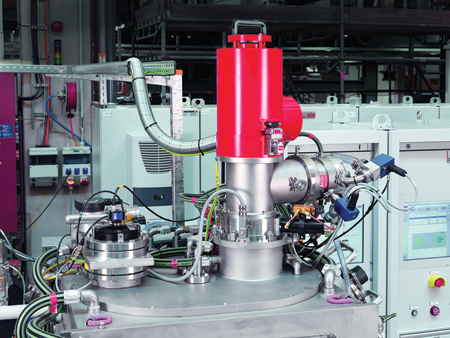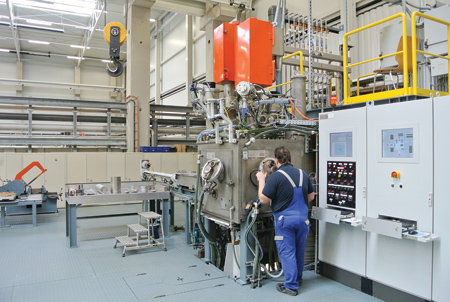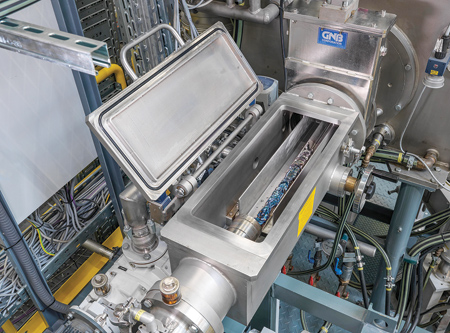
Typically, one or multiple electron beam guns are connected to the melt chamber, depending on required power level and melt surface area to be scanned. ALD Vacuum Technologies features in-house process expertise, furnace design and own gun development resulting in a furnace design matching the requirements of this specific industry. The gun control is fully integrated in the furnace control concept and not an add-on function as offered by other vendors.


EBM is designed for processing high purity, chemical or thermal resistant metals.
Due to their chemical properties, refractory metals have unique performance characteristics that allow their use under extreme conditions, for instance in heat exchangers or other chemical apparatus engineering. Their material characteristics make refractory metals essential for electronic industry applications as well. However, only limited melting processes are suitable for the refining of such materials. The high melting point and chemical reactivity excludes utilizing ceramic crucibles, atmospheric melting conditions as well as most melting techniques. Electron beam melting (EBM) meets the higher temperature requirements as well as providing inert melting conditions. Nevertheless, furnace design and process need to be adapted for such dedicated requirements to match material purity and economical requirements.
ALD Vacuum Technologies provides a specialized EBM service with its own electron beam gun design that allows for precise power distribution, process-optimized material feeding and refining, as well as selected superheating above 3,500 °C. Due to an independent parameter control including power profile, melt rate or vacuum level, the process is highly flexible and cost-efficient. All parts of the plant in contact with the melt itself are removable or easy to reach, so cleaning can be carried out quickly during material changes. In addition, the company operates two furnaces for melting refractory metals for customers who do not have internal capacity available.
Despite their rarity, refractory metals are key materials for innovative high-tech industries that require chemical resistant and highly conductive parts. "However, such metals like hafnium, niobium and tantalum have very high melting points of even over 3,000 °C and therefore require correspondingly high temperatures, which many conventional induction furnaces and refractory crucibles cannot provide," said Jochen Flinspach, Operational Manager EBM Service at ALD Vacuum Technologies. "Reaction of the melt pool with the crucible made of refractory material like zirconium oxide can lead to inclusions of foreign particles in the melt, which can have problematic consequences for subsequent processing, like worse conductive properties or lower resistance of the fabricated parts. Furthermore, these metals are reactive in a higher temperature range, i.e., above liquidus temperature. Therefore, even minimal oxygen input leads to a severe impairment of the material quality and melting under vacuum or inert gas conditions is required. In addition, with conventional melting methods, the gas value inside the melting chamber can often be too high, causing the material to become brittle."
With EBM, not only required temperatures for the melting process are achievable. The flexible power distribution and high vacuum conditions feature unique refining capabilities. Typically, one or multiple electron beam guns are connected to the melt chamber, depending on required power level and melt surface area to be scanned. ALD Vacuum Technologies features in-house process expertise, furnace design and own gun development, resulting in a furnace design matching the requirements of this specific industry. The gun control is fully integrated in the furnace control concept and not an add-on function as offered by other vendors. Thus, interactions between individual furnace functions and implementation of process related logic is ensured. Modern melting furnaces offer semi-automated operation where human interaction is requested for corrective functions only. High reproducibility on process results as well as reliable furnace operation are the benefits of such a development.
ALD Technologies GmbH has developed unique EBM plants for various applications over the years with its own gun and furnace design. Due to its expertise and R&D capabilities, the plant types are suitable for processing high purity, chemical or thermal resistant metals. As specific application, the refining of tantalum or other reactive refractory metals as alloying agents for superalloys is possible. "EBM has been established as a variable process capable of producing material with highest purity and gas contents lower than 10 PPM. It is also suitable for mass production of reactive metals or alloys required for aerospace or chemical applications," said Flinspach.
Electron Gun Allows Precise Melting
ALD offers complete EBM solutions for a wide range of plant configurations, which differ primarily in terms of customer-specific material feed or process implementation. "The heart of every system is our electron beam gun, a high-performance heat source that can reach temperatures above the melting or even vaporization point of all materials at the beam's point of impact," Flinspach explained. Magnetic deflection and fast, high-frequency scanning processes allow the electron beam to be precisely directed to work areas of different shapes while maintaining a strong and uniform power distribution. The gun and its operation are tailored to the specific plant concept. This allows the user to adjust parameters like the shape of the beam pattern and dwell-time or the positioning to their liking, thus avoiding shadow effects that could negatively impact material quality. In addition, the plant runs in vacuum conditions typically below 10-4 mbar down to even 10-6 mbar. In combination with the deliberate superheating of the melt through the strong beam, refining the metal to the highest purity and lowest gas content is feasible, which facilitates the further processing of the material.
For maximum beam efficiency, ALD offers the automated beam control system ECOSYS, which helps ensure optimal energy distribution. The handling is practice-oriented, processes are largely automated and the operator only performs a corrective task. Process visualization provides relevant data clearly arranged on a screen, while details can be called up on corresponding pages if required. "Furthermore, simple and safe cleaning of the equipment is as important as flexible control, since the metal to be melted can change frequently during production schedule," added Ulrich Biebricher, Remelting & Melting Specialist at ALD Vacuum Technologies. Therefore, particular attention is paid to easy maintenance of the equipment. Robust design, good accessibility and quick replacement of components in touch with the melt are features of the plant design. Thus, maintenance of equipment and EB guns can be carried out by the operator alone.
Test Melts and Recovery of Metals from Used Parts
ALD offers more than just customized EBM systems to interested parties. In addition, the company operates two EBM furnaces of different sizes at its headquarters and can therefore optimally adapt to customers who do not have sufficient capacities for processing refractory metals at their disposal. "Our 60 kW EB plant is suitable for ingots up to 100 mm in diameter and 500 mm in length. It is used for smaller material quantities or laboratory and research applications as well as precious metals melting," Biebricher explained. "Our 600 kW plant was designed for ingots starting at 42 mm up to 300 mm in diameter and 2,000 mm in length." The range of melting materials at ALD includes refining high-purity metals for the electronics industry, preparing refractory or reactive metals for chemical usage, as well as consolidating return material from a wide variety of applications. Test melts for customers to qualify new process steps are also part of the portfolio, as is the preparation of metal samples. "In a recent project, tantalum was recovered from used capacitors. We processed it from the scraps into a semi-finished product and conditioned it further for the customer. In the end, the product quality was good enough for reuse in further processing or selling it as precursor," Flinspach said.
Authored by ALD Vacuum Technologies GmbH
For more information contact:
ALD Vacuum Technologies GmbH
info@ald-vt.de
www.ald-vt.com